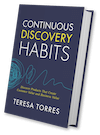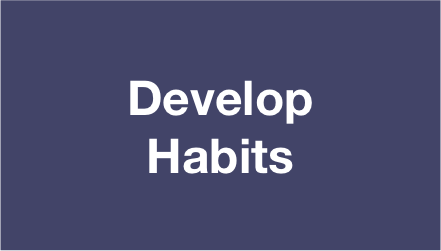 Have you heard? My new book Continuous Discovery Habits is now available. Get the product trio's guide to a structured and sustainable approach to continuous discovery.
Have you heard? My new book Continuous Discovery Habits is now available. Get the product trio's guide to a structured and sustainable approach to continuous discovery. It’s December which means it’s time to reflect on the year and look forward to the coming year.
Last week, I wrote about my annual retrospective and how I choose priorities for the coming year.
Today, I’ll explain how I translate those priorities into goals, design processes to reach those goals, and develop habits to support those processes.
Translate Priorities into Measurable Goals
There’s no shortage of great content on how to set measurable goals.
Most of us are familiar with S.M.A.R.T. goals.
I’ve written about how to set goals that drive product success and how exponential goals get you exponential results.
Google has popularized the Objectives and Key Results (OKRs) framework which is similar to how I translate priorities in to goals.
I also like the way Jason Selk in Ten Minute Toughness defines three different types of goals: ultimate goals, product goals, and process goals.
He defines your ultimate goal as “the culmination of what you want to accomplish and how you want to accomplish it”; product goals as measurable, results-oriented goals, that are accomplishable in the next twelve months; and process goals as “what it takes to achieve the product goals you set.”
My annual priorities support my ultimate goals and I translate those into product goals and process goals for the year.
Translate priorities into product and process goals. – Tweet This
One of my ultimate goals is to develop an end-to-end product management curriculum. Another is to be well-read and widely-read.
Two of my priorities in 2016 will be course design and reading.
However, defining priorities isn’t enough. I also need to define product goals to encourage measurable progress throughout the year.
For my course design priority, I plan to set a couple of product goals.
The first is to limit my time on consulting work so that I have more time to devote to course design. A product goal might be: Limit consulting to no more than 20 hours per week with no more than 5 days of travel per month.
The second product goal to support course design will be a quality measure. It might be: Serve at least 100 students with 20 NPS promoters.
I may need a third goal to ensure that I spend my free time on course design. It might be: Spend at least 5 days per month on course design.
For my reading priority, I plan to set a product goal to read for at least one hour each day.
Design Processes to Reach Your Goals
I can’t just say I want to limit my consulting time, grow my student base, and read for an hour a day and expect to hit my goals.
I need to outline how I am going to make it happen. I need to define processes to help me achieve these goals. I do this by deconstructing each goal.
Define processes to help you achieve your product goals by deconstructing each goal. – Tweet This
If I want to limit my consulting hours, I need to get clear on who I’ll say yes to and who I’ll refer elsewhere.
I’ll need to calendar everything so that I don’t overbook myself.
I’ll need to ensure that I use my remaining time for course design. I’ll need to block out hours or days on my calendar on a recurring basis just for this purpose.
Adding time to my calendar helps me see how much time it will take and allows me to assess how feasible it is.
The quality goal has both a customer satisfaction and a volume component. If my course quality is high, students should be NPS promoters and refer other students to me.
I know from past experience that I can hit quality goals by allotting enough time to do the job properly and by not moving on to the next project until the quality is where I want it to be.
I’ve already blocked out time on my calendar, now I need to define how I’ll know if a course is good enough to move on to the next course.
This might be: Keep developing a course until at least x% of students are NPS promoters. This acts as a safeguard against jumping to the next course too soon.
For my reading goal, I need to get clear on where and when I’ll read each day. I’m leaning toward reading first thing in the morning.
Before I settle on these goals, I need to assess whether or not the processes are feasible.
I like to set goals that make me uncomfortable, but not so uncomfortable that I abandon them.
Set goals that make you uncomfortable. But not so uncomfortable you abandon them. – Tweet This
The hardest goal for me will be limiting my consulting time. I love working with product teams. I want to say yes to everyone.
But I believe that courses will have a bigger impact over time as they scale much better than consulting.
Before I can commit to this goal, I’ll need to assess my ability to stick to it.
Same goes for my reading goal. Will I always be able to start my day with an hour of reading?
I want to pay attention to the days that fall outside of my usual routine (the exceptions) as this is when my processes typically fall apart.
Develop Habits that Support Your Processes
Looking at the exceptions is my first step toward investing in habits.
Each of these processes are filled with assumptions.
I’m assuming that I’ll respect my calendar and not schedule over a block devoted to course design.
I’m assuming that I’ll get up and read for an hour a day. This means that when I have somewhere to be first thing in the morning, I’ll wake up an hour early.
I need to turn those assumptions into habits.
Uncover the assumptions behind each goal and turn them into habits. – Tweet This
This is the hardest part of this process. And when I don’t hit a goal, it’s usually because my habits fell apart.
The following guidelines help me when developing habits:
- Focus on rewards and punishments.
- Build in redundancies.
- Monitor progress and adjust.
To develop habits, focus on rewards and punishments, build redundancies, and monitor and adjust. – Tweet This
For my course design goal, I might reward myself for completing a scheduled course design session and I might punish myself for scheduling over one.
I like to tie redundancies to rewards and punishments. For example, I might define the following rules:
- If at the end of each quarter, I’ve hit my course design goal, then go on a reading vacation.
- If not, stay home and work on course design.
The idea of sitting on a beach with nothing to do but reading a pile of books while sipping on Mai Tais sounds like heaven.
This structure gives me an incentive to work toward and if I miss it, I still get my course design done.
For my reading goal, it’s easy for me to get up and read on most days. But I need to manage the exceptions.
I might not wake up an hour early when I have to get up at 4am to head to the airport. Or I might sleep right up until my 8am call, if I had a late night the night before.
The best way I account for these exceptions is to build in redundancy. I use guidelines like the following:
- If you don’t read first thing in the morning, read over lunch.
- If you don’t read over lunch, read before bed.
- If you don’t read before bed, read for two hours the next morning.
It simple, but it’s hard to do in practice. The guidelines take the guesswork out of it.
My goal with both is to start to develop habits. I always work on course design on Tuesday and Friday afternoons. I always read first thing in the morning.
I don’t want to waste mental energy trying to figure out when and where to do these things. I just want them to happen.
I find it’s not the initial habit that’s hard. It’s accounting for the exceptions. So I always try to think through what might go wrong ahead of time.
I also build in periodic checks throughout the year (both monthly and quarterly) to monitor my progress toward each goal and to adjust as needed.
If a habit isn’t sticking, I might adjust the reward, increase the severity of the punishment, or change the habit altogether.
Separate Planning from Doing
One of the best lessons I learned from David Allen’s Getting Things Done is to separate planning from doing.
This is the goal of my annual review process. The more that I can plan ahead for how I might reach my goals, the more I can focus on executing throughout the year.
Plan how you’ll reach each goal, so that throughout the year you can focus on executing. – Tweet This
My goal is to not wonder what I should be doing. I want to put each incremental step on auto-pilot, so that at the end of the year I can look back in awe at what I accomplished.
Do you have an annual review process? I’d love to hear about it in the comments.
Next week, I’ll be posting one of my most popular posts of the year – my favorite books. Don’t miss it. Subscribe to the Product Talk mailing list.


